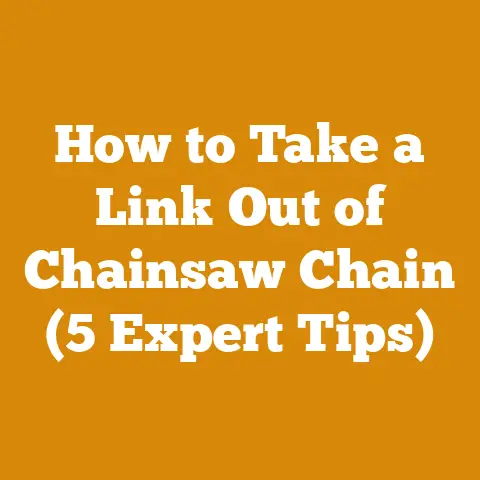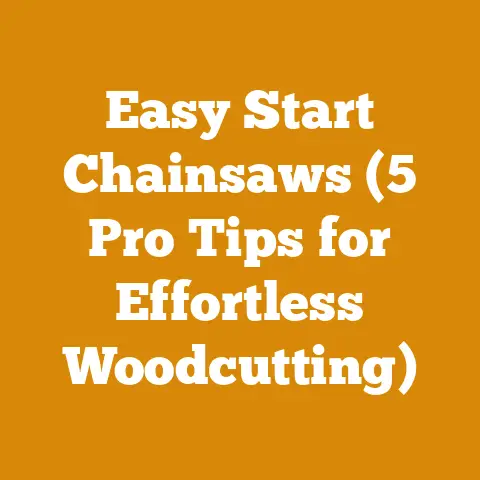Is Stump Grinding a Good Business? (5 Pro Tips for Wood Pros)
In our pursuit of smart living, we often look for ways to be resourceful, efficient, and environmentally conscious. For those of us with a passion for the outdoors and a knack for working with wood, the idea of starting a stump grinding business might just spark some interest. It’s a niche market, to be sure, but one that can be surprisingly lucrative and fulfilling. I’ve spent years in the wood processing and firewood preparation industry, from felling timber with my trusty Stihl MS 462 R C-M chainsaw to meticulously stacking cords of seasoned oak, and I’ve seen firsthand how a well-executed stump grinding operation can fill a real need and turn a solid profit.
So, is stump grinding a good business? The answer, like most things in life, is nuanced. But I’m here to break it down for you, drawing on my experience and offering five pro tips to help you decide if this venture is right for you.
Is Stump Grinding a Good Business? (5 Pro Tips for Wood Pros)
Before diving into the nitty-gritty, let’s level-set. What exactly is stump grinding, and why does it matter?
Stump grinding is the process of removing tree stumps, usually with a specialized machine called a stump grinder. These machines use a high-speed cutting wheel to chip away at the stump, turning it into mulch. Why is this important?
- Aesthetics: Stumps are unsightly and can detract from the curb appeal of a property.
- Safety: Stumps can be tripping hazards, especially for children and the elderly.
- Space: Stumps take up valuable space in yards, preventing homeowners from using the area for planting, building, or other activities.
- Pest Control: Stumps can attract insects, such as termites and ants, which can then infest nearby structures.
- New Planting: You can’t plant a new tree, shrub, or even grass where a stump is.
Now that we understand the basics, let’s get into the pro tips.
Tip 1: Know Your Market – Dig Deep Before You Grind
Understanding your local market is absolutely crucial before investing in any business, and stump grinding is no exception. I remember when I first started offering firewood services; I assumed everyone wanted oak. I quickly learned that in certain neighborhoods, people preferred the cleaner burn of birch, while others prioritized the long-lasting heat of maple. Similarly, with stump grinding, the demand can vary significantly depending on your location.
- Residential Areas: Are there many mature trees in residential areas? Are homeowners actively landscaping and improving their properties?
- Construction Sites: New construction often involves tree removal, creating a demand for stump grinding services.
- Municipalities: Local governments may need stump grinding services for parks, public spaces, and road construction projects.
- Tree Service Companies: Partnering with tree service companies can provide a steady stream of referrals. They often remove trees but don’t offer stump grinding themselves.
How to Conduct Market Research:
- Drive Around: Literally drive around your target area and look for properties with visible stumps. Make note of the size and number of stumps.
- Online Research: Check online directories and review sites to see if there are existing stump grinding services in your area. Analyze their pricing, service offerings, and customer reviews.
- Talk to Tree Service Companies: Reach out to local tree service companies and ask about their stump grinding needs. This is invaluable.
- Check Local Classifieds and Online Marketplaces: See what people are charging for similar services in your area.
Pricing Considerations:
Pricing is a key aspect of market analysis. You need to find a balance between being competitive and making a profit. Here are a few common pricing models:
- Per-Inch Pricing: This is the most common method. You charge a certain amount per inch of stump diameter. Rates can vary, but typically range from $2 to $5 per inch.
- Example: A 20-inch stump at $3 per inch would cost $60.
- Hourly Rate: This is suitable for large jobs or when the stump is difficult to access. Hourly rates can range from $75 to $150 per hour.
- Flat Rate: This is used for smaller stumps or when you can quickly assess the job’s complexity.
- Minimum Charge: Essential to make smaller jobs worth your time and transport costs. I always insist on a minimum charge of $75, regardless of stump size.
Data and Insights:
In my experience, residential areas with older trees and active landscaping projects offer the most consistent demand. I’ve also found that partnering with tree service companies is a great way to get referrals. For example, I have a standing agreement with a local tree service where I give them a 10% commission on any stump grinding jobs they refer to me. This benefits both of us.
Case Study:
I once took on a job in a newly developed subdivision. The developer had cleared the land for construction but left hundreds of small stumps behind. I negotiated a bulk rate with the developer and spent several weeks grinding stumps. It was a physically demanding job, but it was also incredibly profitable. This illustrates the importance of being able to identify and capitalize on opportunities.
Tip 2: Invest in the Right Equipment – Quality Over Cost
The quality of your equipment will directly impact your efficiency, profitability, and reputation. Skimping on equipment can lead to breakdowns, delays, and unhappy customers. I’ve learned this the hard way. In my early days, I tried to save money by buying a used, lower-quality chainsaw for felling. It broke down constantly, costing me time and money in repairs.
Types of Stump Grinders:
- Walk-Behind Stump Grinders: These are the most common type, suitable for residential and smaller commercial jobs. They are relatively compact and easy to maneuver.
- Tow-Behind Stump Grinders: These are larger and more powerful, designed for larger stumps and more demanding jobs. They require a vehicle with a tow hitch.
- Self-Propelled Stump Grinders: These are the most expensive type, offering the highest level of power and maneuverability. They are ideal for professional stump grinding services.
Key Features to Consider:
- Engine Power: The engine power determines the grinder’s ability to cut through tough stumps. Look for models with at least 25 horsepower for walk-behind grinders and 35 horsepower for tow-behind grinders.
- Cutting Wheel Diameter: A larger cutting wheel allows you to grind stumps more quickly and efficiently.
- Cutting Depth: The cutting depth determines how far below the ground you can grind the stump. Aim for a cutting depth of at least 12 inches.
- Maneuverability: Consider the grinder’s weight, size, and wheel configuration. A more maneuverable grinder will be easier to use in tight spaces.
- Safety Features: Look for grinders with safety features such as a chip deflector, emergency shut-off switch, and operator presence control.
Recommended Brands and Models:
- Vermeer: Vermeer is a well-known brand in the tree care industry, offering a range of high-quality stump grinders. Their SC252 is a popular walk-behind model.
- Rayco: Rayco is another reputable brand, known for its durable and powerful stump grinders. Their RG25 is a popular choice for professionals.
- Carlton: Carlton is a long-standing manufacturer of tree care equipment, including stump grinders. Their SP4012 is a self-propelled model with excellent performance.
Beyond the Grinder:
Don’t forget about other essential equipment:
- Personal Protective Equipment (PPE): Safety glasses, hearing protection, work gloves, steel-toed boots, and long pants are a must.
- Shovels and Rakes: For clearing debris and leveling the ground after grinding.
- Wheelbarrow: For transporting mulch.
- Truck and Trailer: For transporting the stump grinder and other equipment.
- First Aid Kit: In case of minor injuries.
Maintenance is Key:
Regular maintenance is essential for keeping your stump grinder in good working condition. This includes:
- Sharpening the Cutting Teeth: Dull teeth will slow you down and put unnecessary strain on the engine. I recommend sharpening the teeth every 8-10 hours of use.
- Changing the Oil: Follow the manufacturer’s recommendations for oil changes.
- Greasing the Bearings: Keep the bearings properly greased to prevent wear and tear.
- Inspecting the Belts and Hoses: Replace any worn or damaged belts and hoses.
- Cleaning the Air Filter: A clean air filter will ensure optimal engine performance.
Cost Considerations:
Stump grinders can range in price from a few thousand dollars for a basic walk-behind model to tens of thousands of dollars for a self-propelled model. Consider your budget and the types of jobs you plan to take on when choosing a grinder.
Financing Options:
If you don’t have the cash to purchase a stump grinder outright, you may be able to finance the purchase through a bank or equipment financing company.
Data and Insights:
I’ve found that investing in a higher-quality stump grinder pays off in the long run. While the initial cost may be higher, the increased efficiency, reliability, and durability will save you time and money over the life of the machine. I personally use a Vermeer SC252, which I’ve found to be a reliable and versatile machine for residential jobs.
Tip 3: Master the Technique – It’s More Than Just Grinding
Stump grinding may seem straightforward, but there’s a technique to it that can significantly impact your efficiency and the quality of your work. It’s not just about turning on the machine and letting it rip. I’ve seen plenty of people who think they can just jump in and start grinding, only to end up with a mess and a frustrated customer.
Safety First:
Before you even start the engine, make sure you have a clear understanding of safety procedures.
- Clear the Area: Remove any rocks, debris, or other obstacles from the area around the stump.
- Mark Underground Utilities: Call 811 (in the US) to have underground utilities marked before you start grinding. Hitting a gas line or electrical cable can be catastrophic.
- Wear PPE: Always wear safety glasses, hearing protection, work gloves, steel-toed boots, and long pants.
- Maintain a Safe Distance: Keep bystanders at least 50 feet away from the stump grinder.
Grinding Techniques:
- Start at the Top: Begin grinding at the top of the stump and work your way down. This will prevent the grinder from kicking back.
- Sweep Back and Forth: Use a sweeping motion to grind the stump evenly. Avoid staying in one spot for too long, as this can overheat the cutting teeth.
- Grind Below Ground Level: Grind the stump at least 6-12 inches below ground level to allow for planting or other landscaping activities.
- Control the Mulch: Direct the flow of mulch away from buildings, vehicles, and other objects. You can use a tarp or plywood to contain the mulch.
Dealing with Obstacles:
- Rocks: If you encounter rocks while grinding, stop the machine and remove the rocks. Hitting a rock with the cutting teeth can damage the grinder.
- Roots: Grind the roots as you encounter them. This will help to prevent the stump from regrowing.
- Underground Utilities: If you suspect that there are underground utilities near the stump, stop grinding and call 811.
Cleanup:
- Remove the Mulch: Use a shovel and wheelbarrow to remove the mulch from the area.
- Fill the Hole: Fill the hole with topsoil and compact it.
- Seed or Sod: Seed or sod the area to restore the lawn.
Advanced Techniques:
- Grinding Large Stumps: For large stumps, you may need to make multiple passes. Start by grinding the perimeter of the stump, then work your way towards the center.
- Grinding Stumps Near Structures: When grinding stumps near buildings or other structures, be extra careful to avoid damaging the structures. Use a chip deflector to direct the flow of mulch away from the structures.
- Grinding Stumps on Slopes: Grinding stumps on slopes can be challenging. Use caution and make sure the grinder is stable.
Data and Insights:
I’ve found that taking the time to properly prepare the area around the stump and using the correct grinding techniques can significantly improve my efficiency and the quality of my work. I also use a metal detector to scan the area around the stump for buried objects before I start grinding. This has saved me from damaging my grinder on numerous occasions.
Case Study:
I was once hired to grind a large stump near a customer’s house. The stump was located in a tight space, and I was concerned about damaging the house. I carefully cleared the area around the stump, used a chip deflector to direct the flow of mulch away from the house, and took my time grinding the stump. In the end, the customer was very happy with my work, and I avoided damaging the house.
Tip 4: Customer Service is King – Build Relationships, Not Just Remove Stumps
In any service-based business, customer service is paramount. It’s not enough to just grind stumps; you need to provide a positive experience for your customers. I’ve always believed that word-of-mouth is the best form of advertising, and happy customers are the key to generating referrals.
Communication is Key:
- Respond Promptly: Respond to customer inquiries quickly and professionally.
- Provide Clear Estimates: Provide clear and detailed estimates that outline the scope of work, the price, and the payment terms.
- Keep Customers Informed: Keep customers informed of your progress and any changes to the schedule.
- Answer Questions: Be prepared to answer customer questions about the stump grinding process.
Professionalism Matters:
- Dress Appropriately: Dress professionally when meeting with customers.
- Be Punctual: Arrive on time for appointments.
- Be Respectful: Treat customers with respect and courtesy.
- Clean Up After Yourself: Leave the job site clean and tidy.
Going the Extra Mile:
- Offer Additional Services: Consider offering additional services such as tree trimming, landscaping, or firewood delivery.
- Provide a Guarantee: Offer a guarantee on your work.
- Follow Up: Follow up with customers after the job is complete to ensure they are satisfied.
Handling Complaints:
- Listen Carefully: Listen carefully to the customer’s complaint.
- Apologize: Apologize for any inconvenience.
- Offer a Solution: Offer a fair and reasonable solution to the problem.
- Learn from Your Mistakes: Learn from your mistakes and take steps to prevent them from happening again.
Building Relationships:
- Get to Know Your Customers: Take the time to get to know your customers and their needs.
- Stay in Touch: Stay in touch with your customers through email, social media, or newsletters.
- Offer Loyalty Programs: Offer loyalty programs to reward repeat customers.
Data and Insights:
I’ve found that providing excellent customer service is the best way to build a successful stump grinding business. I always go the extra mile to make sure my customers are happy, and I’ve received many referrals as a result.
Case Study:
I once had a customer who was very upset because I had accidentally damaged her sprinkler system while grinding a stump. I immediately apologized and offered to pay for the repairs. I also went out of my way to make sure the repairs were done quickly and professionally. The customer was so impressed with my response that she not only hired me for another job but also referred me to several of her friends.
Tip 5: Business Acumen – It’s Not Just About the Grind
While mastering the technical aspects of stump grinding and providing excellent customer service are essential, you also need to have a solid understanding of business principles to succeed. I’ve seen many talented tradespeople struggle because they lacked the business acumen to manage their finances, market their services, and grow their business.
Financial Management:
- Track Your Income and Expenses: Keep accurate records of your income and expenses.
- Create a Budget: Create a budget to track your cash flow and ensure you are making a profit.
- Manage Your Taxes: Understand your tax obligations and file your taxes on time.
- Invest in Insurance: Invest in liability insurance to protect your business from lawsuits.
Marketing and Sales:
- Create a Website: Create a website to showcase your services and attract new customers.
- Use Social Media: Use social media to promote your business and connect with customers.
- Network: Network with other businesses and professionals in your area.
- Advertise: Advertise your services in local newspapers, magazines, and online directories.
- Offer Discounts and Promotions: Offer discounts and promotions to attract new customers.
Legal and Regulatory Compliance:
- Obtain the Necessary Licenses and Permits: Obtain the necessary licenses and permits to operate your business legally.
- Comply with Environmental Regulations: Comply with all environmental regulations related to stump grinding.
- Follow Safety Regulations: Follow all safety regulations to protect your employees and customers.
Business Planning:
- Develop a Business Plan: Develop a business plan to outline your goals, strategies, and financial projections.
- Set Realistic Goals: Set realistic goals for your business.
- Track Your Progress: Track your progress towards your goals and make adjustments as needed.
- Seek Advice: Seek advice from experienced business owners or consultants.
Scaling Your Business:
- Hire Employees: Hire employees to help you handle the workload.
- Invest in More Equipment: Invest in more equipment to increase your efficiency and capacity.
- Expand Your Service Area: Expand your service area to reach more customers.
- Offer New Services: Offer new services to diversify your business.
Data and Insights:
I’ve found that having a solid understanding of business principles is essential for long-term success in the stump grinding industry. I use accounting software to track my income and expenses, and I regularly review my financial statements to identify areas where I can improve my profitability.
Case Study:
I once had a competitor who was charging significantly lower prices than I was. I knew that I couldn’t compete on price alone, so I focused on providing superior customer service and building a strong brand. Over time, I was able to attract more customers and increase my prices, while my competitor eventually went out of business.
Next Steps
So, is stump grinding a good business? Hopefully, these five pro tips have given you a clearer picture. If you’re passionate about the outdoors, enjoy working with your hands, and are willing to put in the hard work, it can be a rewarding and profitable venture.
Here are some practical next steps you can take:
- Further Market Research: Conduct thorough market research in your specific area to assess the demand for stump grinding services.
- Equipment Evaluation: Research and compare different stump grinder models to find the best fit for your needs and budget.
- Training and Certification: Consider taking a stump grinding training course to learn the proper techniques and safety procedures.
- Business Plan Development: Develop a detailed business plan that outlines your goals, strategies, and financial projections.
- Legal and Regulatory Compliance: Ensure that you have all the necessary licenses, permits, and insurance to operate your business legally.
Starting a stump grinding business requires dedication, hard work, and a willingness to learn. But with the right equipment, skills, and business acumen, you can build a successful and fulfilling career. Good luck, and happy grinding!






